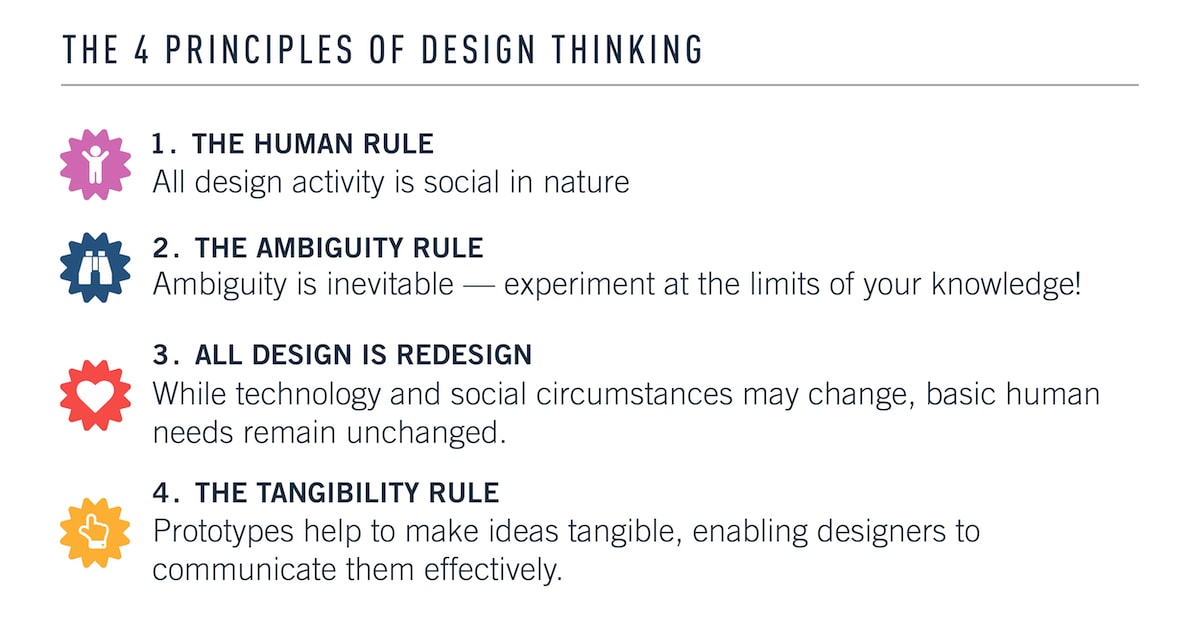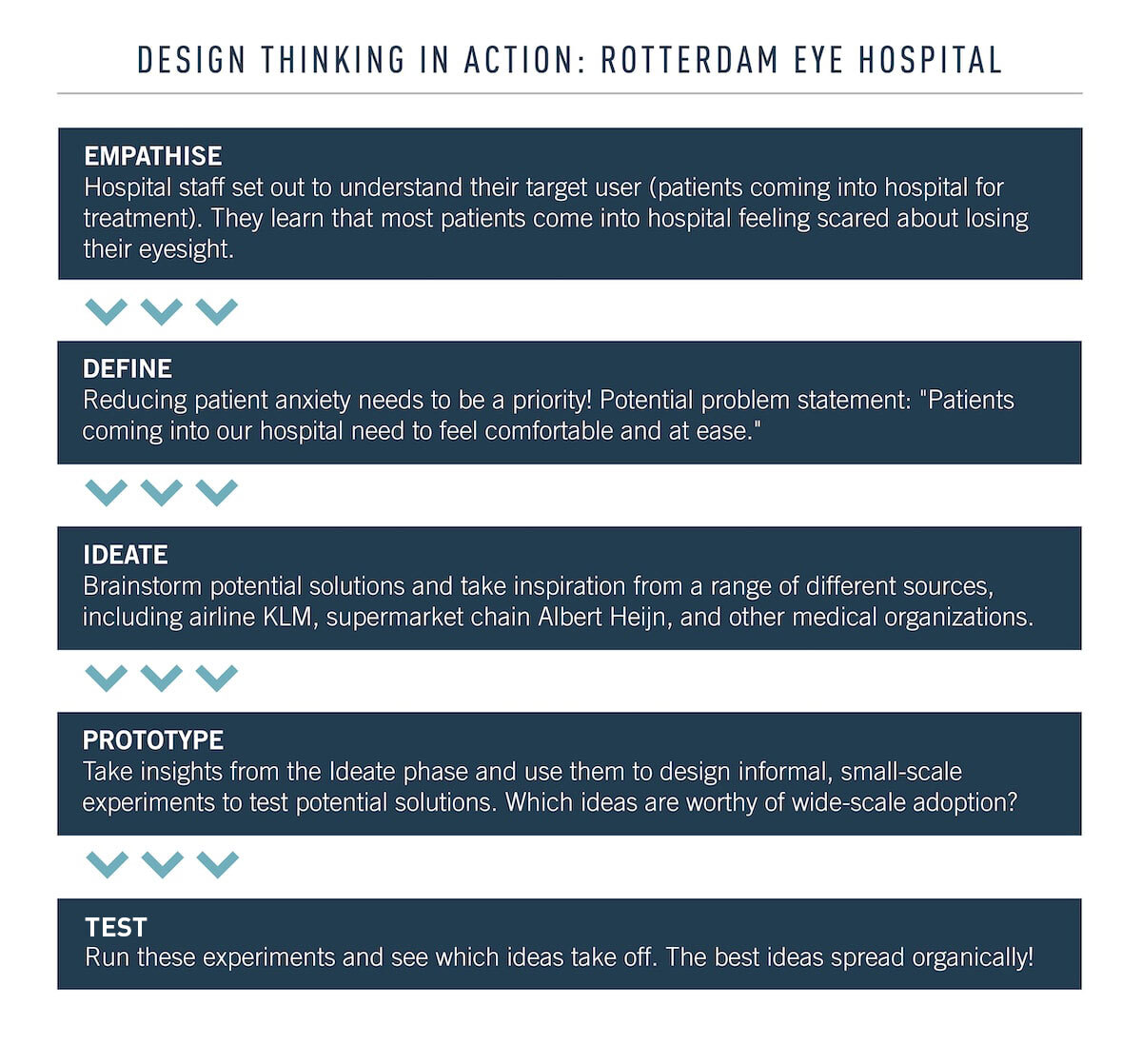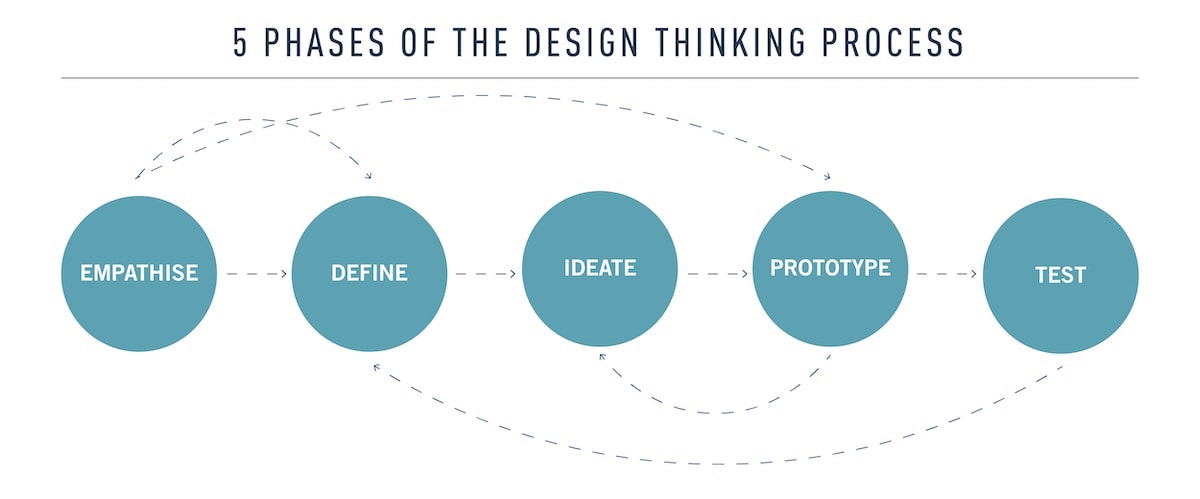Design thinking is both an ideology and a process, concerned with solving complex problems in a highly user-centric way.
In this guide, we’ll give you a detailed definition of design thinking, illustrate exactly what the process involves, and underline why it matters: What is the value of design thinking, and in what contexts is it particularly useful?
We’ll also analyze the relationship between user experience design and design thinking and discuss two real-world case studies that show design thinking in action.
All sound a little overwhelming? Don’t worry—we’ve broken the guide down into digestible chunks.
If you want to skip to a certain section, just click on the relevant menu heading and you’ll go straight there.
- What is Design Thinking?
- What is the Design Thinking process?
- What is the purpose of Design Thinking?
- How do Design Thinking, lean, and agile work together?
- What are the benefits of Design Thinking at work?
- Design Thinking methodology in action: Case studies
- What is the relationship between Design Thinking and UX Design?
Ready to explore the fascinating world of Design Thinking? Let’s go!
1. What is Design Thinking?
Design thinking is an approach used for practical and creative problem-solving. It is based heavily on the methods and processes that designers use (hence the name), but it has actually evolved from a range of different fields—including architecture, engineering and business. Design thinking can also be applied to any field; it doesn’t necessarily have to be design-specific.
For an audio-visual introduction, watch this video from design expert and CareerFoundry mentor, Camren Browne:
It’s important to note that design thinking is different from user-centered design. Learn more about this other approach to design here: Design Thinking vs. User-Centered Design.
Design thinking is extremely user-centric. It focuses on humans first and foremost, seeking to understand people’s needs and come up with effective solutions to meet those needs. It is what we call a solution-based approach to problem-solving.
What does this actually mean? Let’s take a look.
What’s the difference between Solution-Based and Problem-Based Thinking?
As the name suggests, solution-based thinking focuses on finding solutions; coming up with something constructive to effectively tackle a certain problem. This is the opposite of problem-based thinking, which tends to fixate on obstacles and limitations.
A good example of these two approaches in action is an empirical study carried out by Bryan Lawson, a Professor of Architecture at the University of Sheffield. Lawson wanted to investigate how a group of designers and a group of scientists would approach a particular problem.
He set each group the task of creating one-layer structures from a set of coloured blocks. The perimeter of the structure had to use either as many red bricks or as many blue bricks as possible (we can think of this is as the solution, the desired outcome), but there were unspecified rules regarding the placement and relationship of some of the blocks (the problem or limitation).
Lawson published his findings in his book How Designers Think, in which he observed that the scientists focused on identifying the problem (problem-based thinking) whilst the designers prioritized the need to find the right solution:
“The scientists adopted a technique of trying out a series of designs which used as many different blocks and combinations of blocks as possible as quickly as possible. Thus they tried to maximise the information available to them about the allowed combinations. If they could discover the rule governing which combinations of blocks were allowed, they could then search for an arrangement which would optimise the required colour around the layout.”
The designers, on the other hand:
“…selected their blocks in order to achieve the appropriately coloured perimeter. If this proved not to be an acceptable combination, then the next most favourably coloured block combination would be substituted and so on until an acceptable solution was discovered.”
Lawson’s findings go to the heart of what Design Thinking is all about: it’s an iterative process which favours ongoing experimentation until the right solution is found.
To learn more, check out this video introduction to design thinking, led by expert designer Camren Browne. For now, let’s take a look at the design thinking process and what that entails.
2. What is the Design Thinking process?
As already mentioned, the Design Thinking process is progressive and highly user-centric. Before looking at the process in more detail, let’s consider the four principles of Design Thinking as laid out by Christoph Meinel and Harry Leifer of the Hasso-Plattner-Institute of Design at Stanford University, California.

The Four Principles of Design Thinking
- The human rule: No matter what the context, all design activity is social in nature, and any social innovation will bring us back to the “human-centric point of view”.
- The ambiguity rule: Ambiguity is inevitable, and it cannot be removed or oversimplified. Experimenting at the limits of your knowledge and ability is crucial in being able to see things differently.
- The redesign rule: All design is redesign. While technology and social circumstances may change and evolve, basic human needs remain unchanged. We essentially only redesign the means of fulfilling these needs or reaching desired outcomes.
- The tangibility rule: Making ideas tangible in the form of prototypes enables designers to communicate them more effectively.
The Five Phases of Design Thinking
Based on these four principles, the Design Thinking process can be broken down into five steps or phases, as per the aforementioned Hasso-Plattner-Institute of Design at Stanford (otherwise known as d.school): Empathise, Define, Ideate, Prototype and Test. Let’s explore each of these in more detail.
Phase 1: Empathise
Empathy provides the critical starting point for Design Thinking. The first stage of the process is spent getting to know the user and understanding their wants, needs and objectives.
This means observing and engaging with people in order to understand them on a psychological and emotional level. During this phase, the designer seeks to set aside their assumptions and gather real insights about the user. Learn all about key empathy-building methods in our guide.
Phase 2: Define
The second stage in the Design Thinking process is dedicated to defining the problem. You’ll gather all of your findings from the empathise phase and start to make sense of them: what difficulties and barriers are your users coming up against? What patterns do you observe? What is the big user problem that your team needs to solve?
By the end of the define phase, you will have a clear problem statement. The key here is to frame the problem in a user-centered way; rather than saying “We need to…”, frame it in terms of your user: “Retirees in the Bay area need…”
Once you’ve formulated the problem into words, you can start to come up with solutions and ideas — which brings us onto stage three.
Phase 3: Ideate
With a solid understanding of your users and a clear problem statement in mind, it’s time to start working on potential solutions. The third phase in the Design Thinking process is where the creativity happens, and it’s crucial to point out that the ideation stage is a judgement-free zone!
Designers will hold ideation sessions in order to come up with as many new angles and ideas as possible. There are many different types of ideation technique that designers might use, from brainstorming and mindmapping to bodystorming (roleplay scenarios) and provocation—an extreme lateral-thinking technique that gets the designer to challenge established beliefs and explore new options and alternatives.
Towards the end of the ideation phase, you’ll narrow it down to a few ideas with which to move forward. You can learn about all the most important ideation techniques in this guide.
Phase 4: Prototype
The fourth step in the Design Thinking process is all about experimentation and turning ideas into tangible products. A prototype is basically a scaled-down version of the product which incorporates the potential solutions identified in the previous stages. This step is key in putting each solution to the test and highlighting any constraints and flaws.
Throughout the prototype stage, the proposed solutions may be accepted, improved, redesigned or rejected depending on how they fare in prototype form. You can read all about the prototyping stage of Design Thinking in our in-depth guide.
Phase 5: Test
After prototyping comes user testing, but it’s important to note that this is rarely the end of the Design Thinking process. In reality, the results of the testing phase will often lead you back to a previous step, providing the insights you need to redefine the original problem statement or to come up with new ideas you hadn’t thought of before. Learn all about user testing in this guide.
Is Design Thinking a linear process?
No! You might look at these clearly defined steps and see a very logical sequence with a set order. However, the Design Thinking process is not linear; it is flexible and fluid, looping back and around and in on itself! With each new discovery that a certain phase brings, you’ll need to rethink and redefine what you’ve done before—you’ll never be moving in a straight line!
3. What is the purpose of Design Thinking?
Now we know more about how Design Thinking works, let’s consider why it matters. There are many benefits of using a Design Thinking approach—be it in a business, educational, personal or social context.
First and foremost, Design Thinking fosters creativity and innovation. As human beings, we rely on the knowledge and experiences we have accumulated to inform our actions. We form patterns and habits that, while useful in certain situations, can limit our view of things when it comes to problem-solving.
Rather than repeating the same tried-and-tested methods, Design Thinking encourages us to remove our blinkers and consider alternative solutions. The entire process lends itself to challenging assumptions and exploring new pathways and ideas.
Design Thinking is often cited as the healthy middle ground of problem-solving—it is not steeped wholly in emotion and intuition, nor does it rely solely on analytics, science and rationale; it uses a mixture of both.
Another great benefit of Design Thinking is that it puts humans first. By focusing so heavily on empathy, it encourages businesses and organizations to consider the real people who use their products and services—meaning they are much more likely to hit the mark when it comes to creating meaningful user experiences. For the user, this means better, more useful products that actually improve our lives. For businesses, this means happy customers and a healthier bottom line.
What’s a “wicked problem” in Design Thinking?
Design Thinking is especially useful when it comes to solving “wicked problems”. The term “wicked problem” was coined by design theorist Horst Rittel in the 1970s to describe particularly tricky problems that are highly ambiguous in nature.
With wicked problems, there are many unknown factors; unlike “tame” problems, there is no definitive solution. In fact, solving one aspect of a wicked problem is likely to reveal or give rise to further challenges. Another key characteristic of wicked problems is that they have no stopping point; as the nature of the problem changes over time, so must the solution.
Solving wicked problems is therefore an ongoing process that requires Design Thinking! Some examples of wicked problems in our society today include things like poverty, hunger, and climate change.
If you’d like to learn more about them, and how Design Thinking can help tackle them, check out our full guide to wicked problems.
4. Design Thinking in the workplace: How do Design Thinking, lean, and agile work together?
Now we know what Design Thinking is, let’s consider how it fits into the overall product design process. You may be familiar with the terms “lean” and “agile”—and, as a UX designer, it’s important to understand how these three approaches work together.
What are lean and agile?
Based on the principles of lean manufacturing, lean UX focuses on streamlining the design process as much as possible—minimizing waste and maximizing value. Some core tenets of lean UX are:
- Cross-functional collaboration between designers, engineers, and product managers.
- Gathering feedback quickly and continuously, ensuring that you’re constantly learning and adapting as you go.
- Deciding as late as possible and delivering fast, with less focus on long-term deliverables.
- A strong emphasis on how the team operates as a whole.
Lean UX is a technique that works in conjunction with agile development methods. Agile is a software development process that works in iterative, incremental cycles known as sprints. Unlike traditional development methods, agile is flexible and adaptive. Based on the Agile Development Manifesto created in 2001, agile adheres to the following principles:
- Individuals and interactions over processes and tools.
- Working software over comprehensive documentation.
- Customer collaboration over contract negotiation.
- Responding to change over following a plan.
Combining Design Thinking with lean and agile
Design Thinking, lean, and agile are often seen as three separate approaches. Companies and teams will ask themselves whether to use lean or agile or Design Thinking—but actually, they can (and should!) be merged for optimal results.
Why? Because applying Design Thinking in a lean, agile environment helps to create a product development process that is not only user-centric, but also highly efficient from a business perspective. While it’s true that each approach has its own modus operandi, there is also significant overlap.
Combining principles from each can be crucial in keeping cross-functional teams on the same page—ensuring that designers, developers, product managers, and business stakeholders are all collaborating on one common vision.
So how do Design Thinking, lean, and agile work together?
As Jonny Schneider, Product Strategy and Design Principal at ThoughtWorks, explains: “Design Thinking is how we explore and solve problems; Lean is our framework for testing our beliefs and learning our way to the right outcomes; Agile is how we adapt to changing conditions with software.”
That’s all well and good, but what does it look like in practice?
As we’ve learned, Design Thinking is a solution-based approach to exploring and solving problems. It focuses on generating ideas with a specific problem in mind, keeping the user at the heart of the process throughout. Once you’ve established and designed a suitable solution, you’ll start to incorporate lean principles—testing your ideas, gathering quick and ongoing feedback to see what works—with particular emphasis on cross-team collaboration and overcoming departmental silos.
Agile ties all of this into short sprint cycles, allowing for adaptability in the face of change. In an agile environment, products are improved and built upon incrementally. Again, cross-team collaboration plays a crucial role; agile is all about delivering value that benefits both the end user and the business as a whole.
Together, Design Thinking, lean, and agile cut out unnecessary processes and documentation, leveraging the contributions of all key stakeholders for continuous delivery and improvement.
5. What are the benefits of Design Thinking at work?
As a designer, you have a pivotal role to play in shaping the products and experiences that your company puts to market. Integrating Design Thinking into your process can add huge business value, ultimately ensuring that the products you design are not only desirable for customers, but also viable in terms of company budget and resources.
With that in mind, let’s consider some of the main benefits of using Design Thinking at work:
- Significantly reduces time-to-market: With its emphasis on problem-solving and finding viable solutions, Design Thinking can significantly reduce the amount of time spent on design and development—especially in combination with lean and agile.
- Cost savings and a great ROI: Getting successful products to market faster ultimately saves the business money. Design Thinking has been proven to yield a significant return on investment; teams that are applying IBM’s Design Thinking practices, for example, have calculated an ROI of up to 300% as a result.
- Improves customer retention and loyalty: Design Thinking ensures a user-centric approach, which ultimately boosts user engagement and customer retention in the long term.
- Fosters innovation: Design Thinking is all about challenging assumptions and established beliefs, encouraging all stakeholders to think outside the box. This fosters a culture of innovation which extends well beyond the design team.
- Can be applied company-wide: The great thing about Design Thinking is that it’s not just for designers. It leverages group thinking and encourages cross-team collaboration. What’s more, it can be applied to virtually any team in any industry.
Whether you’re establishing a Design Thinking culture on a company-wide scale, or simply trying to improve your approach to user-centric design, Design Thinking will help you to innovate, focus on the user, and ultimately design products that solve real user problems.
6. Design Thinking methodology in action: Case studies
So we’ve looked in quite some detail at the theory behind Design Thinking and the processes involved — but what does this look like in action? Let’s explore some case studies where Design Thinking has made a huge real-world impact.
Healthcare Case Study: How Design Thinking transformed the Rotterdam Eye Hospital
Executives at the Rotterdam Eye Hospital wanted to transform the patient experience from the typically grim, anxiety-riddled affair into something much more pleasant and personal. To do this, they incorporated Design Thinking and design principles into their planning process. Here’s how they did it:

Empathise
First, they set out to understand their target user — patients entering the hospital for treatment. The hospital CEO, CFO, managers, staff and doctors established that most patients came into hospital with the fear of going blind.
Define
Based on their findings from the empathise stage, they determined that fear reduction needed to be a priority. Their problem statement may have looked something like the following: “Patients coming into our hospital need to feel comfortable and at ease.”
Ideate
Armed with a deep understanding of their patients and a clear mission statement, they started to brainstorm potential solutions. As any good design thinker would, they sought inspiration from a range of both likely and unlikely sources. They looked to flagship airline KLM and supermarket chain Albert Heijn to learn about scheduling, for example, while turning to other medical organizations for inspiration on operational excellence.
Prototype
In the prototyping stage, the team presented the most promising ideas they had come up with so far to those in charge of caregiving at the hospital. These teams of caregivers then used these insights to design informal, small-scale experiments that could test a potential solution and see if it was worthy of wide-scale adoption.
Test
The testing phase consisted of running the aforementioned experiments and seeing if they took off. As Dirk Deichmann and Roel van der Heijde explain, the “transition to formal adoption of these ideas tended to be more gradual. If an idea worked, sooner or later other groups would ask if they could try it too, and the best ideas spread organically.”
The outcome
By adopting a Design Thinking approach, the Rotterdam Eye Hospital were able to get to the heart of their users’ needs and find effective solutions to fulfil them. In doing so, they have greatly improved the user experience: patient intake has risen 47%, and the hospital has since won several awards for safety, quality and design.
Business Case Study: How Design Thinking helped financial service provider MLP regain consumer trust
After the financial crisis hit, financial service provider MLP found that consumer trust was at an all-time low. They needed to re-engage with their target users and come up with new ways of building trust. In search of innovation, they decided to test out a Design Thinking approach. Here’s what they learned:
Empathise
By focusing on their users and making a conscious effort to understand their needs first-hand, MLP learned that the assumptions they’d been going on were not so accurate after all. As Thomas Freese, division manager for marketing at MLP, explains:
“We always used to speak to customers about the goals they want to achieve. But they do not want to commit to a certain goal, as they often do not know themselves what that is. Rather, they want to talk about their ideas as it is more open and flexible regarding their financial planning.”
Define
With this newfound empathy for their users, MLP were able to reframe their mission statement. They knew that they needed to rebuild consumer trust, and that the way to do this would be to speak to the customer in their own language and become a more relatable brand.
Ideate and Prototype
During the ideate and prototype phases, they decided to experiment with a completely new image. Instead of the formal business attire typically associated with the financial sector, the MLP team members went out in casual clothing. They tested Lego prototypes and homemade posters in designated hotspots — including a university campus and train stations.
Test
By testing this new approach, they learned some extremely valuable lessons about their users and how to communicate with them. They found that even something as simple as dressing more casually had a huge impact in reducing the negative connotations associated with financial services. They also learned the value of asking open questions; rather than trying to sell their prototype, Design Thinking taught them to ask questions that focus on the user’s needs.
The Outcome
Their first foray into Design Thinking proved to be a huge learning curve for MLP. Taking the time to speak to their users gave them the insights they needed to redesign their messaging, allowing them to start marketing much more effectively.
In light of their findings, MLP opened up a new office space in a student district, putting their editorial and social media teams in close proximity to their customer base. Of course, Design Thinking is an iterative process, so this is just one way in which MLP hopes to continue learning to speak their customers’ language.
7. What is the relationship between Design Thinking and UX Design?
At this point, you’ve no doubt noticed lots of similarities between Design Thinking and user experience design, and may be wondering how they relate to one another. Both are extremely user-centric and driven by empathy, and UX designers will use many of the steps laid out in the Design Thinking process, such as user research, prototyping and testing.
Despite these similarities, there are certain distinctions that can be made between the two. For one, the impact of Design Thinking is often felt on a more strategic level; it explores a problem space—in the context of understanding users, technological feasibility, and business requirements—to discover possible solutions. As we have seen from the Rotterdam Eye Hospital and MLP case studies, Design Thinking is embraced and implemented by all different teams across the business, including C-level executives.
If Design Thinking focuses on finding solutions, UX design is concerned with actually designing these solutions and making sure they are usable, accessible and pleasant for the user.
You can think of Design Thinking as a toolset that UX designers dip into, and if you’re operating within the UX design field, it is one of many crucial methodologies you’ll rely on when it comes to creating fantastic user experiences. You can learn more about UX Design and Design Thinking in our UX Design Course, as well as earn a design thinking certification by completing a course in it.
Further reading
Want to see what design thinking looks like in practice? Here’s an article for you: 5 Game-Changing Examples of Design Thinking.
And if you’re new to the design field and wondering what all these newfangled terms mean, you may well be interested in the following guides:

